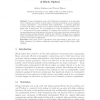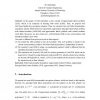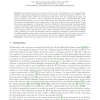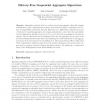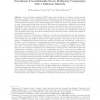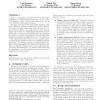104
click to vote
IACR
2011
14 years 16 days ago
2011
Given a lattice L with the i-th successive minimum λi, its i-th gap λi λ1 often provides useful information for analyzing the security of cryptographic schemes related to L. The...
101
click to vote
IACR
2011
14 years 16 days ago
2011
Linear cryptanalysis, along with differential cryptanalysis, is an important tool to evaluate the security of block ciphers. This work introduces a novel extension of linear crypt...
IACR
2011
14 years 16 days ago
2011
103
click to vote
IACR
2011
14 years 16 days ago
2011
Abstract. Sponge functions were introduced by Bertoni et al. as an alternative to the classical MerkleDamg˚ard design. Many hash function submissions to the SHA-3 competition laun...
105
click to vote
IACR
2011
14 years 16 days ago
2011
We present new candidates for quantum-resistant public-key cryptosystems based on the conjectured difficulty of finding isogenies between supersingular elliptic curves. The main t...
116
click to vote
IACR
2011
14 years 16 days ago
2011
Keccak is one of the five hash functions selected for the final round of the SHA-3 competition and its inner primitive is a permutation called Keccakf. In this paper, we find t...
106
click to vote
IACR
2011
14 years 16 days ago
2011
The block cipher family for lightweight devices, KTANTAN, is analyzed in this paper. We propose a new cryptanalysis method which improves results of Meet-in-the-Middle attacks on K...
121
click to vote
IACR
2011
14 years 16 days ago
2011
Aggregation schemes allow to combine several cryptographic values like message authentication codes or signatures into a shorter value such that, despite compression, some notion o...
134
click to vote
IACR
2011
14 years 16 days ago
2011
Secure multiparty computation (MPC) allows a set of n players to compute any public function, given as an arithmetic circuit, on private inputs, so that privacy of the inputs as we...
107
click to vote
IACR
2011
14 years 16 days ago
2011
Companies, organizations, and individuals often wish to share information to realize valuable social and economic goals. Unfortunately, privacy concerns often stand in the way of ...

